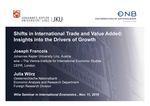The Rise and Fall of International Trade: Deconstructing Trade and Value Added

Joseph F. Francois and Julia Wörz
presented at: The Rise and Fall of International Trade: Deconstructing Trade and Value Added (11 Nov 2010)
related Publication: Shifts in International Trade and Value Added: Insights into the Drivers of Growth - Paper
In this paper we adopt a structuralist approach to analyse the long-run growth of real world exports. We construct a unique dataset combining export, import, output, employment and wage data for 196 countries and 22 manufacturing industries over the period 1995-2009. Decomposing global export growth into its structural components, we find that regional as well as sectoral shifts of emerging economies into more trade intensive activities account for a large part of the increase in world export volume. Once we move the analysis to the level of individual industries, we also find that trade (i.e. exports in our case) does not 'over-react' to output growth. Hence, the often cited rising elasticity of global trade to income can in fact also be explained by changes in the country and industry composition of global trade with more strongly growing economies moving rapidly into more trade-intensive activities, with the elasticity of trade to income at the sectoral level remaining well below one.
Keywords: trade growth, industrial export structure, Central, Eastern and Southeastern Europe
JEL classification: F14, F15, O52
Countries covered: Central, East and Southeast Europe
Research Areas: International Trade, Competitiveness and FDI